Puckaster is a hamlet on the Isle of Wight, England. Puckaster is on the southern coast of the Isle of Wight, south of Niton , between St. Catherine's Point and Binnel.
Puckaster is a hamlet on the Isle of Wight, England. Puckaster is on the southern coast of the Isle of Wight, south of Niton , between St. Catherine's Point and Binnel.
Puckaster has historical significance. Some have tried to identify Puckaster Cove with the Roman "Portus Castrensis" [1] although others dispute this. [2] Also, on 1 July 1675 King Charles II was forced ashore in Puckaster Cove in bad weather and heavy seas, [3] [4] as recorded in the Niton Church Register:
"July the 1st, Anno Domini 1675. Charles II, king of Great Britain, France, and Ireland, etc., came safely ashore at Puckaster, after he had endured a great and dangerous storm at sea." [5]
Vice-Admiral Sir Thomas Hopsonn as an orphan lived in Niton. Seeing the fleet passing offshore he literally ran away to sea, down Puckaster Lane and into a rowing boat, later distinguishing himself, especially at the Battle of Vigo Bay in 1702 and returning to become a local Member of Parliament. He is mentioned by Samuel Smiles in Self Help. The coastline around Puckaster is quite treacherous, leading to the creation of St. Catherine's Oratory on St. Catherine's Down and eventually other lighthouses in the area. Among the other shipwrecks near Puckaster was that of the West Indianman "Three Sisters". The Three Sisters went aground at Puckaster in January 1799. Three of the crew were drowned in this accident. [6]
Puckaster is part of the Undercliff, a large coastal landslide complex along the southern coastline of the Isle of Wight, and as such is subject to coastal erosion concerns. [7] [8] [9] [10] [11] It is also the home of some rare bees and other unique insects. Its unique climate allows the growth of some plants that are found nowhere else in the British Islands; this was even the subject of a publication by philosopher and economist John Stuart Mill. [12] To this end, Puckaster Farm was purchased in an effort to preserve this area. [13]
Puckaster Cove sits on the coastline beneath the hamlet, immediately east of Reeth Bay and west of Binnel Bay. It is a small remote cove that is now largely inaccessible and dangerous due to landslides. It has a narrow and rocky shoreline with a small shingle beach. The remains of several wooden structures and cleared sand channels can be seen offshore, these originate from the small fishing community that once existed at the cove, which was subsequently destroyed by landslides during the 20th century. As at Reeth Bay the cove is backed by in-situ cliffs of Lower Greensand, with superficial mudflows and landslide debris from the Gault Clay (known locally as 'Blue Slipper') and Upper Greensand.
Puckaster has inspired several renowned paintings and drawings. For example, British painter Edward William Cooke (1811–1880) made a watercolor of Puckaster Cove in 1831. [14] The Brigham Young University Museum of Art owns an anonymous drawn plan of a Puckaster dwelling [15] and a watercolor of a Puckaster cottage. [16] Mrs. W. Bartlett and W. Willis made a well known etching of Puckaster Cove that was published in "Barber's Picturesque Illustrations of the Isle of Wight" in 1845. [17] The Tate Collection includes a drawing by artist Sir David Wilkie (1785–1841) titled, "Sir Willoughby Gordon and his Daughter Julia, Cooking on a Griddle at Puckaster, near Niton, Isle of Wight 1822". [18] Painters L. J. Wood and Richard Henry Nibbs (1816–1893) have also produced notable paintings of Puckaster.
Yacht designer and builder Uffa Fox lived in Puckaster. Prince Philip stayed in Puckaster as a young man when he was learning to sail. [19]
Author Cassandra Eason identifies Puckaster as a place which is frequented by fairies in her book, "A Complete Guide to Fairies & Magical Beings". [20]
Puckaster has its own flag which references the Buddle Inn and the tin trade with Cornwall, the history of smuggling on its coast, St Catherine's Lighthouse, the local landmark and three anchors which reference the Isle of Wight and safe anchorage at the Isle of Wight.

The Isle of Wight is a county and the largest and second-most populous island in England. It is in the English Channel, between two and five miles off the coast of Hampshire, separated by the Solent. The island has resorts that have been holiday destinations since Victorian times, and is known for its mild climate, coastal scenery, and verdant landscape of fields, downland and chines. The island is designated a UNESCO Biosphere Reserve.
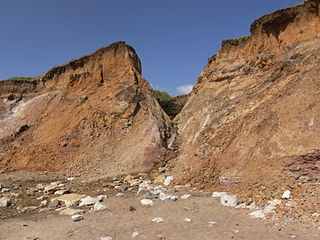
A chine is a steep-sided coastal gorge where a river flows to the sea through, typically, soft eroding cliffs of sandstone or clays. The word is still in use in central Southern England—notably in East Devon, Dorset, Hampshire and the Isle of Wight—to describe such topographical features. The term 'bunny' is sometimes used to describe a chine in Hampshire. The term chine is also used in some Vancouver suburbs in Canada to describe similar features.

Ventnor is a seaside resort and civil parish established in the Victorian era on the southeast coast of the Isle of Wight, England, eleven miles (18 km) from Newport. It is situated south of St Boniface Down, and built on steep slopes leading down to the sea. The higher part is referred to as Upper Ventnor ; the lower part, where most amenities are located, is known as Ventnor. Ventnor is sometimes taken to include the nearby and older settlements of St Lawrence and Bonchurch, which are covered by its town council. The population of the parish in 2016 was about 5,800.

Blackgang Chine is the oldest amusement park in the United Kingdom, having opened in the 1840s. Named after a now-destroyed chine in the soft Cretaceous cliffs, it is about 6 miles from Ventnor at the southern tip of the Isle of Wight just below St Catherine's Down. Blackgang Chine and its sister park Robin Hill are owned by the Dabell family. Blackgang Chine is home to a series of imaginatively themed lands, including a Pirate Cove, a realm of Dinosaurs, an Underwater Kingdom, a Fairy Village and a Cowboy Town. Owing to the unstable land on which the park is situated, landslides occur frequently, meaning that attractions have been moved further inland to safer ground on several occasions.

St Lawrence is a village on the south side of the Isle of Wight, in southern England. It is located to the west of Ventnor and many consider it a part of that town. St Lawrence is situated on the Undercliff, and is subject to frequent landslips. The village is a 1 1⁄2-mile (2.4 km) strip along the coast next to the English Channel, nearby bays include: Woody Bay, Mount Bay and Orchard Bay. The area of the village is around 329 acres (133 ha) in size.

Freshwater is a large village and civil parish at the western end of the Isle of Wight, England. Freshwater Bay is a small cove on the south coast of the Island which also gives its name to the nearby part of Freshwater. Freshwater sits at the western end of the region known as the Back of the Wight or the West Wight which is a popular tourist area.

Niton is a village on the Isle of Wight, west of Ventnor, with a population of 2,082. It has one pub, several churches, a pottery workshop/shop, a pharmacy, a busy volunteer-run library, a medical centre and three local shops including a post office. The post office includes a café that serves as a local meeting place. The village also offers a primary school with a co-located pre-school and nursery.
The Undercliff is the name of several areas of landslip on the south coast of England. They include ones on the Isle of Wight; on the Dorset-Devon border near Lyme Regis; on cliffs near Branscombe in East Devon; and at White Nothe, Dorset. All arose from slump of harder strata over softer clay, giving rise to irregular landscapes of peaks, gullies and slipped blocks, that have become densely vegetated due to their isolation and change of land use. The Kent coast at Folkestone and Sandgate also has similar undercliff areas.
Professor Robin McInnes OBE is an English chartered geologist and chartered civil engineer who is an authority on coastal management and ground instability problems; he lives and works on the Isle of Wight, UK. He is a Visiting Professor at the Department of Geography & Environment, University of Southampton. He is also a Fellow of the Institution of Civil Engineers, the Geological Society of London, the Royal Geological Society and the Royal Society of Arts.

The A3055 is an A-Class Road on the Isle of Wight in Southern England. It forms the Southern portion of the circular around-the-Island A-class loop, the northern section being the A3054. The stretch along the south-west coast of the Island is formed by the Military Road.
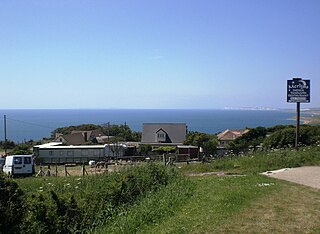
Blackgang is a village on the south-western coast of the Isle of Wight. It is best known as the location of the Blackgang Chine amusement park which sits to the south of St Catherine's Down.
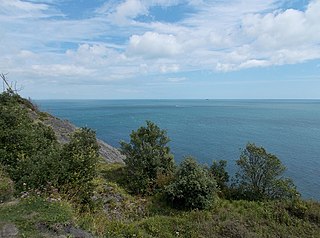
Bonchurch Landslips is a 28.2 hectare site of special scientific interest which is located north-east of Ventnor, Isle of Wight. A wooded coastal landslip zone, the site was notified in 1977 for both its biological and geological features.
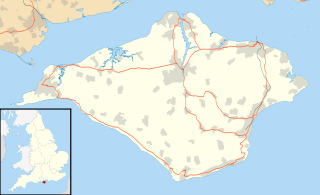
Whale Chine is a geological feature near Chale on the south-west coast of the Isle of Wight, England. One of a number of such chines on the island created by stream erosion of soft Cretaceous and Jurassic rocks, it is a narrow and steep coastal ravine dropping 140 feet through Lower Greensand rocks from clifftop farmland to Chale Bay.
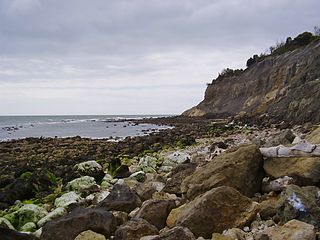
Steel Bay is a bay on the south-east coast of the Isle of Wight, England. It lies to the east of the village of Bonchurch. It faces south-east towards the English Channel and has a one-half-mile (0.80 km) shoreline. It stretches from Bordwood Ledge in the north to Dunnose headland in the south. The bay is remote and has no established access. It is best viewed from Dunnose which can be accessed by scrambling over The Landslip, which is close to the Isle of Wight Coastal Path in the woods to the east of Upper Bonchurch. The bay has a large intertidal reef with outlying rocks, which can be a danger for marine traffic.

Binnel Bay is a bay on the south coast of the Isle of Wight, England. It lies between the villages of St. Lawrence and Niton. It faces south towards the English Channel, and is just under one mile (1.6 km) in length. It stretches from Binnel Point in the east to Puckaster Cove in the west.

Woody Bay is a small bay on the south coast of the Isle of Wight, England. It lies along the coastline beneath the village of St. Lawrence. The bay faces south towards the English Channel, its shoreline is 260 yards (240 m) in length.
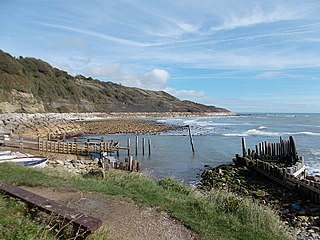
Reeth Bay is a small curved bay on the southernmost tip of the Isle of Wight, England. It lies to the south of the village of Niton with a 1⁄4-mile-long (0.4 km) shoreline. It faces south out into the English Channel and lies to the east of St. Catherine's Point lighthouse. It is at the centre of a small hamlet called Castlehaven where there is a concrete ramp for launching small craft. The beach is predominantly sand and pebbles. The seabed is a mixture of rocks and mud. The bay is best accessed from the road from Niton that leads down to the bay.

Back of the Wight is an area on the Isle of Wight in England. The area has a distinct historical and social background, and is geographically isolated by the chalk hills, immediately to the North, as well as poor public transport infrastructure. Primarily agricultural, the Back of the Wight is made up of small villages spread out along the coast, including Brighstone, Shorwell and Mottistone.

For other locations of the same name, see The Undercliff.

Mount Bay is a small bay with a shingle beach on the south-east Undercliff coastline of the Isle of Wight, England, south of the village of St. Lawrence and west of Ventnor. Its shoreline is 260 yards (240 m) in length. It faces south towards the English Channel and is similar in character to the adjacent Orchard Bay, though without a beachside property. Access to the beach is made down an uneven footpath from the Isle of Wight Coastal Path.
This article lacks ISBNs for the books listed in it.(April 2010) |